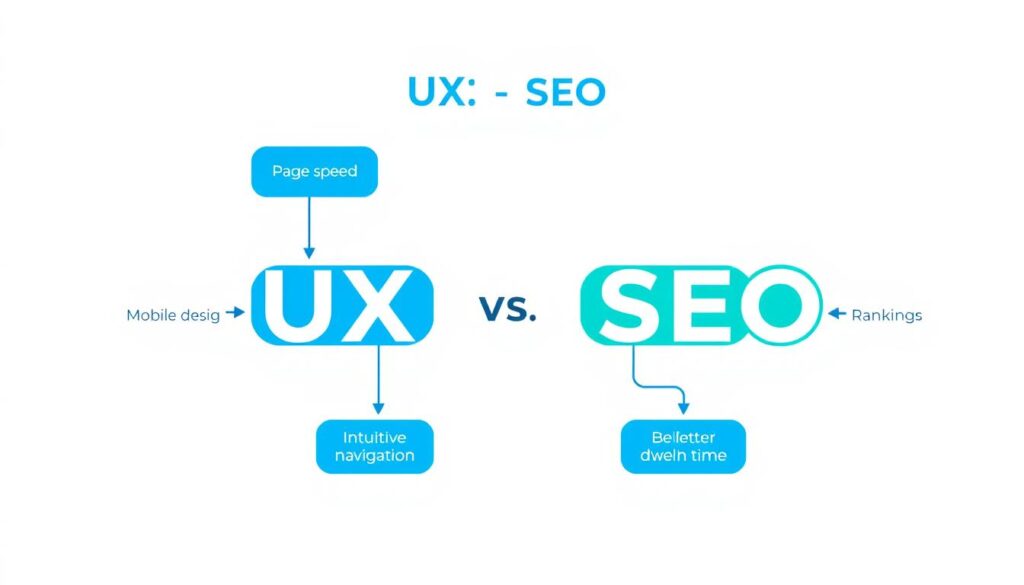
The relationship between user experience (UX) and SEO rankings has become increasingly important in today’s digital landscape. Search engines, particularly Google, now prioritize websites that not only contain relevant content but also provide exceptional user experiences. Understanding how UX and SEO rankings influence each other can be the difference between page one visibility and being lost in the depths of search results.
In this comprehensive guide, we’ll explore the critical connection between user experience design and search engine optimization, revealing how seemingly small UX improvements can dramatically boost your search visibility. You’ll discover actionable strategies that satisfy both human visitors and search algorithms, creating a virtuous cycle of better engagement, higher rankings, and increased conversions.
The Direct Relationship Between UX and SEO Rankings
The cyclical relationship between user experience signals and search engine rankings
User experience and search engine optimization were once treated as separate disciplines. Today, they’re inseparable partners in digital success. Google’s algorithms have evolved to interpret user behavior signals as indicators of content quality and relevance, effectively turning positive user experiences into ranking advantages.
When users find your website easy to navigate, quick to load, and valuable to engage with, they stay longer, explore more pages, and signal to search engines that your site deserves higher visibility. Conversely, poor experiences like slow loading times, confusing navigation, or mobile display issues drive users away quickly—sending negative signals that can harm your rankings.
Page Speed: The UX Factor That Directly Impacts Rankings
Page speed stands as one of the clearest examples of UX directly affecting SEO. Google has confirmed that page speed is a ranking factor, with research showing that 53% of mobile users abandon sites that take longer than three seconds to load. This user behavior creates a double penalty: the ranking algorithm downgrade plus the negative user signals from high bounce rates.
Optimizing images, implementing browser caching, minifying code, and utilizing content delivery networks can dramatically improve load times. Each second saved increases the likelihood of users staying on your site, engaging with your content, and completing desired actions—all positive signals for search engines.
Mobile-Friendliness: Essential for Modern SEO
With Google’s shift to mobile-first indexing, how your site performs on mobile devices now determines how it ranks across all platforms. A responsive design that adapts seamlessly to different screen sizes isn’t just convenient for users—it’s essential for search visibility.
Mobile optimization goes beyond responsive layouts to include touch-friendly navigation, appropriate font sizes, and properly spaced interactive elements. These UX considerations directly impact user engagement metrics that influence rankings, making mobile experience optimization a critical SEO strategy.
Content Accessibility and Structure
How you structure and present content significantly impacts both user experience and search engine crawlability. Clear hierarchical structures with proper heading tags (H1, H2, H3) help users scan content efficiently while simultaneously helping search engines understand content relationships and importance.
Accessible content—with descriptive alt text for images, proper contrast ratios, and keyboard navigation support—improves experiences for all users, including those with disabilities. These accessibility features align perfectly with search engine needs for understanding content context and relevance.
5 Key UX Factors That Boost SEO Rankings
Certain user experience elements have a particularly strong influence on search engine rankings. By focusing on these five key factors, you can create experiences that satisfy both users and search algorithms.
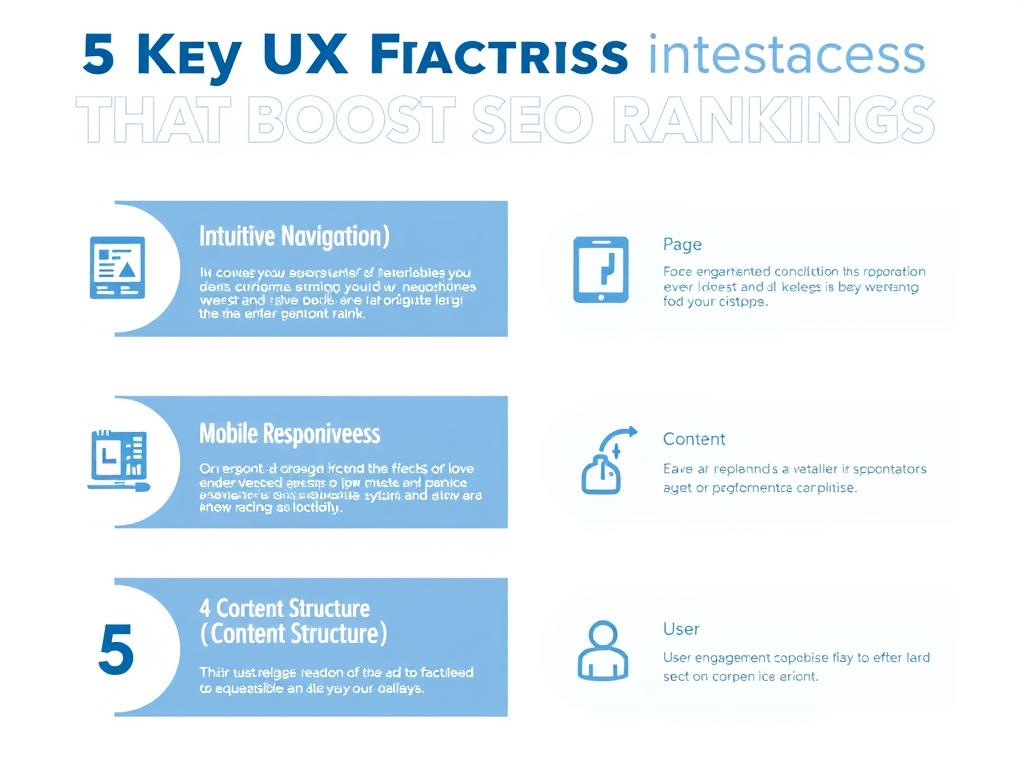
1. Intuitive Navigation Reduces Bounce Rates
When users can easily find what they’re looking for, they’re less likely to bounce back to search results—a key metric search engines use to evaluate content relevance. Intuitive navigation creates clear pathways through your site, encouraging deeper exploration and longer sessions.
Effective navigation strategies include:
- Logical menu structures that reflect user mental models
- Breadcrumb navigation to show location within the site hierarchy
- Consistent placement of navigation elements across pages
- Search functionality for direct access to specific content
- Related content suggestions to encourage further exploration
By reducing friction in the user journey, intuitive navigation keeps visitors engaged with your content longer, sending positive signals to search engines about your site’s value and relevance.
2. Engaging Content Layouts Improve Dwell Time
Dwell time—how long users spend on your page before returning to search results—is a critical signal of content quality. Engaging layouts that make content easy to consume can significantly increase this metric.
Effective content layout strategies include:
- Breaking text into scannable chunks with descriptive subheadings
- Using bullet points and numbered lists for easy information processing
- Incorporating relevant images, diagrams, and videos to illustrate concepts
- Implementing proper white space to reduce cognitive load
- Creating visual hierarchy that guides attention to important elements
When users find your content visually appealing and easy to consume, they spend more time engaging with it—a powerful positive signal for search engines.
3. Mobile-Responsive Design as a Direct Ranking Signal
Google explicitly uses mobile-friendliness as a ranking factor, making responsive design essential for SEO success. Beyond the direct algorithm impact, mobile responsiveness affects user behavior metrics that further influence rankings.
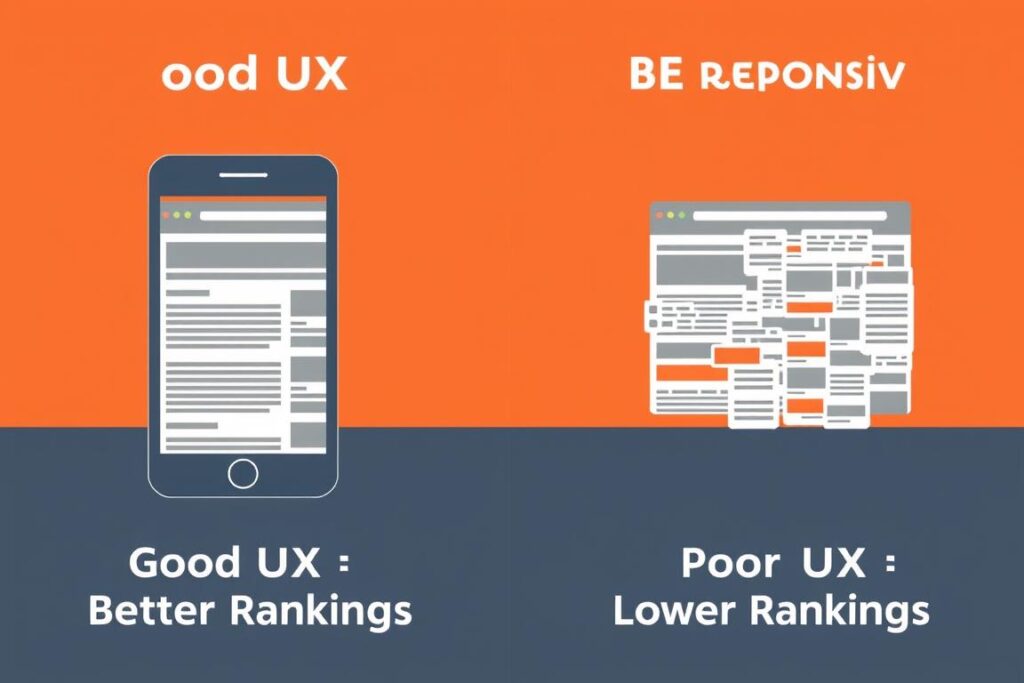
Mobile-responsive design directly impacts both user experience and search rankings
Key mobile responsiveness factors include:
- Fluid layouts that adapt to different screen sizes
- Touch-friendly navigation and interactive elements
- Appropriate font sizes and line spacing for mobile readability
- Optimized images that load quickly on mobile connections
- Simplified forms and conversion paths for mobile users
With mobile traffic now exceeding desktop for many websites, optimizing for mobile users isn’t just good for SEO—it’s essential for business success.
4. Structured Data Implementation for Better Crawlability
Structured data markup helps search engines understand your content’s context and purpose, improving how it’s represented in search results. This technical UX element creates a better experience both for search engines and users seeking specific information.
Effective structured data strategies include:
- Implementing schema.org markup for content types like articles, products, and FAQs
- Using breadcrumb markup to show content hierarchy
- Adding review and rating markup where appropriate
- Implementing FAQ schema for question-based content
- Using local business markup for location-based businesses
Structured data can lead to rich snippets in search results, increasing visibility and click-through rates while helping search engines better understand your content’s value.
5. Accessibility Features Align with SEO Best Practices
Web accessibility improvements often directly benefit SEO by making content more understandable to both users and search engines. Many accessibility best practices mirror SEO requirements for content structure and clarity.
Key accessibility features that boost SEO include:
- Proper heading structure that outlines content hierarchy
- Descriptive alt text for images that provides context
- Transcripts and captions for audio and video content
- Keyboard navigation support for non-mouse users
- Sufficient color contrast for text readability
By making your content accessible to all users, you simultaneously make it more understandable to search engines—creating a win-win for accessibility and SEO.
Real-World Case Studies: UX Improvements That Boosted Rankings
The connection between UX and SEO rankings isn’t just theoretical—it’s proven through real-world results. These case studies demonstrate how specific user experience improvements directly impacted search visibility and traffic.
E-Commerce Site: 40% Traffic Increase After Checkout Redesign
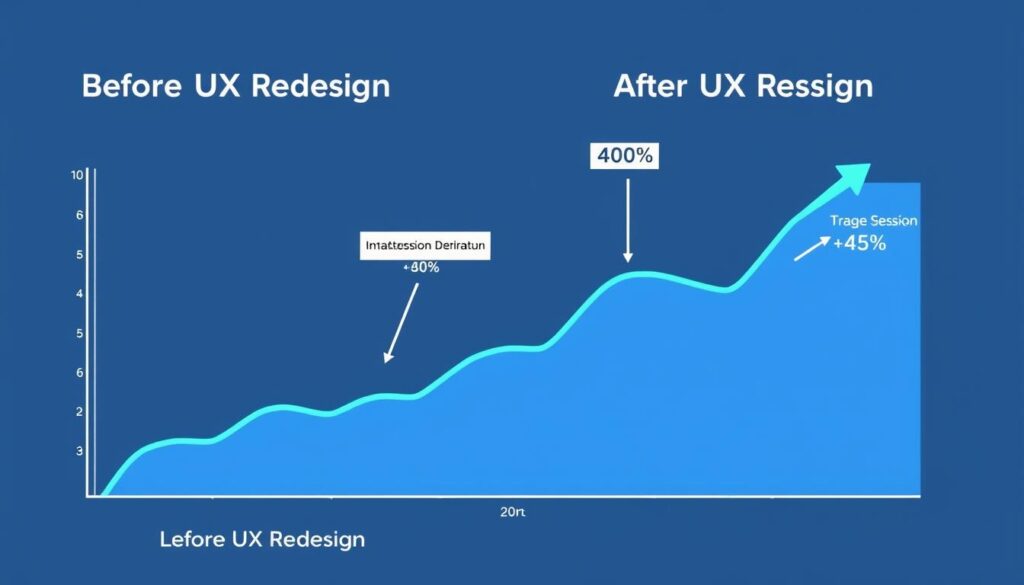
Traffic growth following UX-focused checkout redesign
A mid-sized e-commerce retailer struggled with high cart abandonment rates and declining search visibility. Analysis revealed that their checkout process was causing significant user frustration, with 67% of users abandoning purchases before completion.
The UX redesign focused on:
- Reducing checkout steps from six to three
- Implementing a progress indicator to set expectations
- Adding guest checkout option to remove registration friction
- Optimizing form fields for mobile users
- Improving error message clarity and placement
Results: Within three months, the site experienced a 40% increase in organic search traffic, 28% reduction in bounce rate, and 45% improvement in conversion rate. The improved user signals from completed purchases and longer sessions directly contributed to better search visibility.
B2B Software Company: 65% More Leads Through Navigation Restructuring
A B2B software provider noticed high exit rates on key landing pages despite strong initial traffic. User testing revealed confusion about service offerings and difficulty finding relevant information.
The UX improvement strategy included:
- Reorganizing the main navigation based on user mental models
- Implementing clear category pages with visual distinction
- Adding contextual internal linking between related services
- Creating a resource hub for educational content
- Simplifying the lead generation form from 12 fields to 5
Results: The changes led to a 65% increase in qualified leads, 52% improvement in pages per session, and a 35% boost in organic search visibility for target keywords. The reduced exit rates and increased engagement sent strong positive signals to search engines about content relevance.
News Publication: 83% Mobile Traffic Growth After Speed Optimization
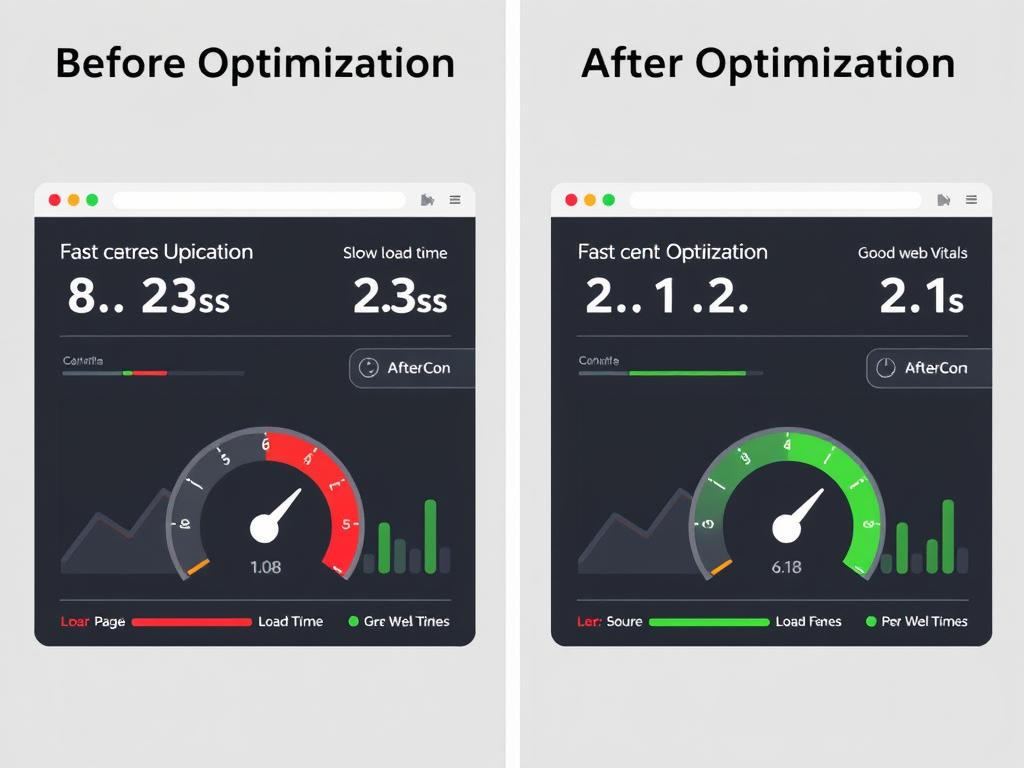
Mobile performance metrics before and after speed optimization
A digital news publication was experiencing declining mobile traffic despite quality content. Analysis revealed extremely slow page load times on mobile devices, averaging 8.2 seconds—well above the recommended 3-second threshold.
The speed optimization strategy included:
- Implementing adaptive image loading based on device capabilities
- Restructuring ad delivery to prioritize content loading
- Utilizing browser caching for returning visitors
- Implementing AMP (Accelerated Mobile Pages) for news content
- Reducing third-party script impact through asynchronous loading
Results: The publication achieved an 83% increase in mobile organic traffic, 76% improvement in pages per session, and 94% reduction in mobile bounce rate. Google Search Console data showed significant ranking improvements for key news terms, directly attributable to the enhanced mobile experience.
Actionable Tips for Optimizing UX and SEO Simultaneously
Improving both user experience and search visibility doesn’t have to be overwhelming. These practical strategies help you identify opportunities and implement changes that benefit both users and search engines.

Heatmap analysis revealing user engagement patterns and navigation pain points
Using Heatmaps to Identify Navigation Pain Points
Heatmap tools like Hotjar, Crazy Egg, and Microsoft Clarity provide visual representations of how users interact with your pages. These insights reveal where users get stuck, what they ignore, and how they navigate your content.
Implementation tips:
- Install heatmap tracking on high-traffic and high-value pages
- Look for “dead zones” where important content gets ignored
- Identify rage clicks that indicate user frustration
- Analyze scroll depth to see where users abandon content
- Compare desktop and mobile interaction patterns to spot device-specific issues
By addressing the pain points revealed through heatmap analysis, you can create smoother user journeys that reduce bounce rates and increase engagement—both positive signals for search engines.
A/B Testing Meta Content with User Journey Analysis
The connection between search results and on-page experience is critical. A/B testing different meta titles and descriptions while monitoring the subsequent user journey can reveal which search snippets set the right expectations.
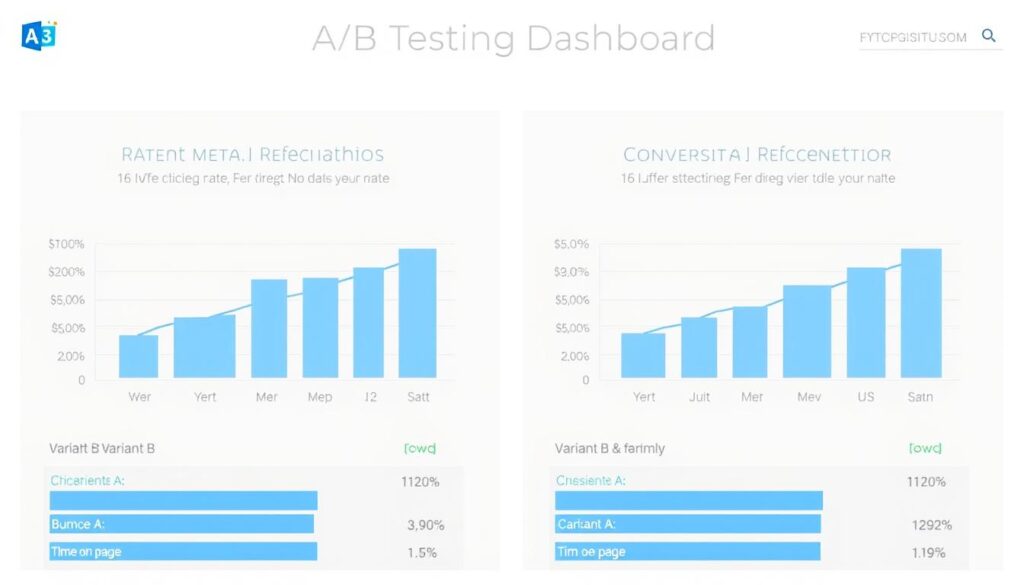
A/B testing results comparing engagement metrics for different meta descriptions
Implementation tips:
- Test different value propositions in meta descriptions
- Compare question-based vs. statement-based meta titles
- Analyze how different meta content affects bounce rates
- Track conversion paths from different search snippet variations
- Use Google Search Console click-through rate data to inform testing
By aligning search snippets with on-page experience, you create a seamless transition from search results to your content, reducing bounce rates and improving engagement metrics.
Implementing Schema Markup for Rich Snippets
Schema markup helps search engines understand your content’s context and can lead to enhanced search results with star ratings, FAQs, and other rich features that improve visibility and click-through rates.
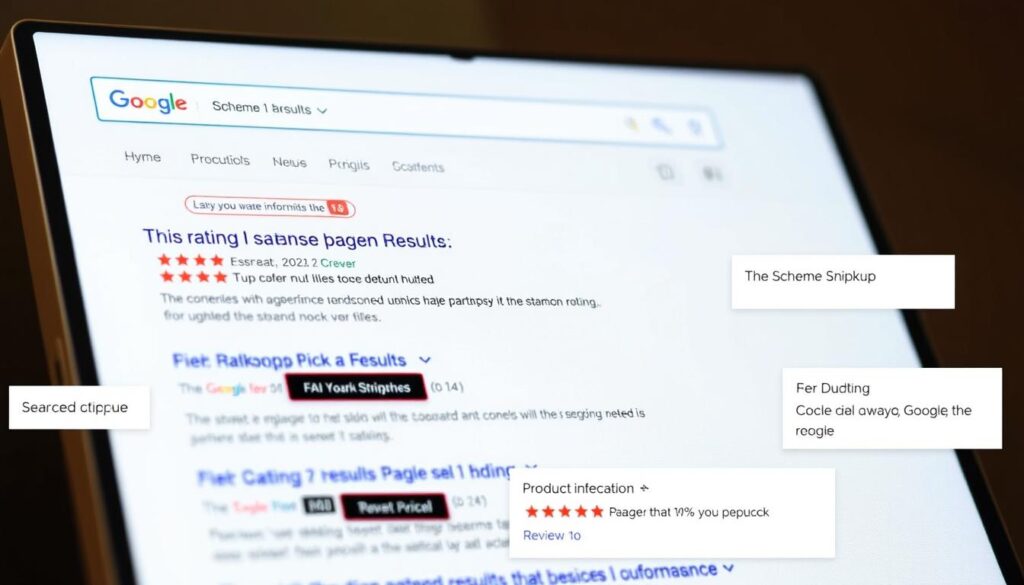
Rich snippets in search results created through schema markup implementation
Implementation tips:
- Use Google’s Structured Data Testing Tool to validate markup
- Implement FAQ schema for question-based content
- Add review schema for products and services with ratings
- Include breadcrumb markup to show content hierarchy
- Implement article schema with author and publication date information
Rich snippets not only improve search visibility but also set clearer expectations for users, leading to better alignment between search intent and on-page experience.
Optimizing for Core Web Vitals
Google’s Core Web Vitals—Largest Contentful Paint (LCP), First Input Delay (FID), and Cumulative Layout Shift (CLS)—directly measure aspects of user experience that impact both satisfaction and search rankings.
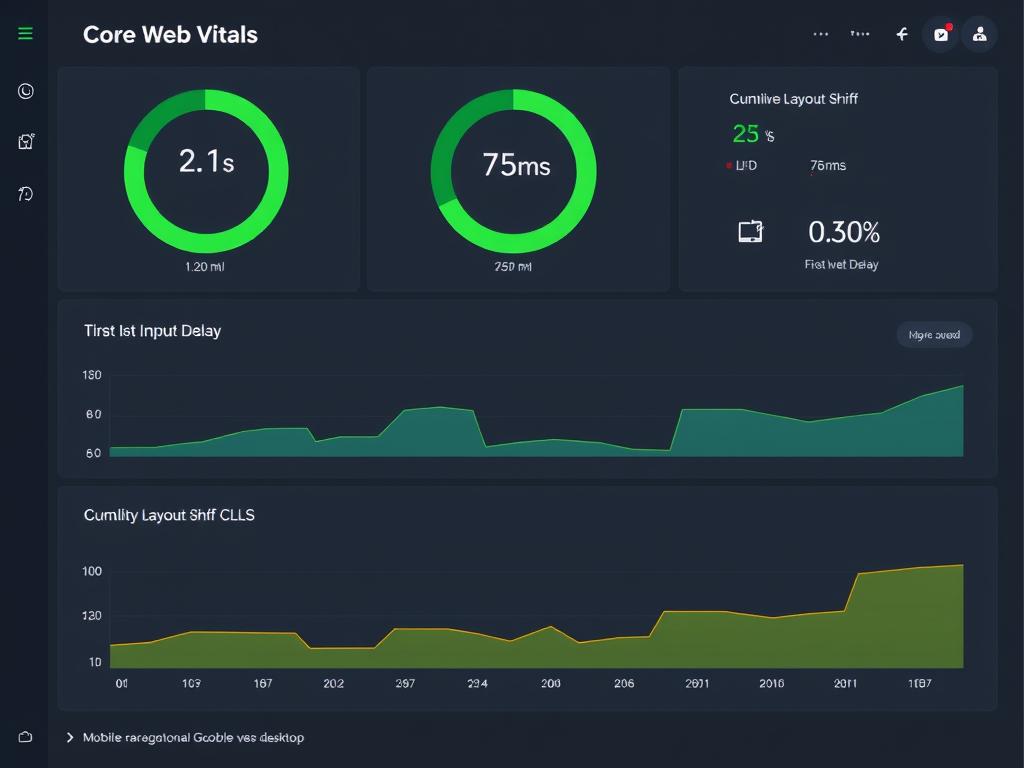
Core Web Vitals dashboard showing performance metrics across devices
Implementation tips:
- Use Google PageSpeed Insights to identify specific improvement opportunities
- Optimize image delivery with proper sizing and next-gen formats
- Minimize render-blocking resources that delay content display
- Reserve space for dynamic elements to prevent layout shifts
- Implement critical CSS to speed up initial rendering
By optimizing Core Web Vitals, you directly improve both the user experience and the technical signals Google uses for ranking decisions.
7 UX Elements Search Engines Love: Your Implementation Checklist
Ready to take action? This checklist highlights the most impactful UX elements that directly influence search rankings. Use it to prioritize your optimization efforts for maximum SEO benefit.

Your UX-SEO Implementation Checklist
- Optimize Page Speed: Ensure all pages load in under 3 seconds on both mobile and desktop devices. Compress images, leverage browser caching, and minimize render-blocking resources.
- Implement Responsive Design: Ensure your site adapts seamlessly to all screen sizes with properly sized touch targets, readable text without zooming, and no horizontal scrolling.
- Create Clear Navigation Paths: Implement logical menu structures, breadcrumb navigation, and internal linking that helps users find related content easily.
- Structure Content Properly: Use proper heading hierarchy (H1, H2, H3), short paragraphs, bullet points, and descriptive subheadings to make content scannable.
- Implement Schema Markup: Add structured data for your content type (articles, products, FAQs, etc.) to help search engines understand context and potentially earn rich snippets.
- Optimize for Core Web Vitals: Address specific issues with Largest Contentful Paint, First Input Delay, and Cumulative Layout Shift to meet Google’s performance thresholds.
- Ensure Accessibility: Implement proper alt text for images, sufficient color contrast, keyboard navigation support, and proper ARIA labels for interactive elements.
The Future of UX and SEO Rankings: Integrated Optimization
As search engines continue to refine their algorithms to better reflect user preferences, the line between UX and SEO will blur even further. The most successful websites will be those that recognize these disciplines as two sides of the same coin—both focused on delivering exceptional experiences that satisfy user needs.
By implementing the strategies outlined in this guide, you’re not just optimizing for today’s search algorithms but building a foundation for sustainable search visibility. Remember that every UX improvement that helps real users navigate, consume, and engage with your content more effectively also sends positive signals to search engines about your site’s value and relevance.
Start with the highest-impact areas—page speed, mobile responsiveness, and content structure—then progressively enhance other aspects of the user experience. Track both user behavior metrics and search rankings to identify correlations and opportunities for further optimization.
The future belongs to websites that deliver exceptional experiences for both users and search engines. Is your site ready?
Leave a Reply